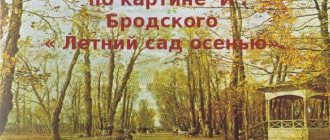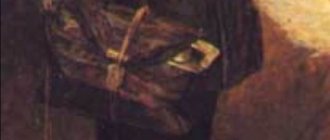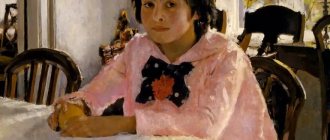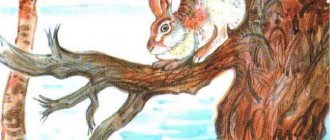- Essays
- According to paintings
- Surikov
/
/
The artist painted the picture for 4 years. The theme of the picture is the beginning of the liberation of Russia from Tatar-Mongol rule. By order of Tsar Ivan the Terrible, the Cossack ataman Ermak set out to expand the borders and recapture Siberia from Khan Kuchum.
The painting depicts the moment of the Cossacks attacking the Tatars. It happens in shallow water. Some Cossacks sit in boats, the most impatient ones stand knee-deep in the water and shoot. The Cossacks are determined - they have pressed the Tatars to a high bank and are finishing them off. The Russians were not stopped by the fact that it was more difficult to attack from the water. This is the final moment of the battle.
The picture is made in dark colors. There is no sun, leaden clouds hang in the gray sky. And the water in the river is gray and cold. And the gray coast. And the Cossacks’ clothes are gray, green, and brown. They weren’t going to a parade - such clothes are practical and non-staining. Only one of them has a red caftan. The Tatars are desperately resisting, but they have no chance - they are pressed against a high bank.
And even the cavalry on the shore will not save them. Moreover, she is removed from the battlefield. In water it will be meaningless. The Cossacks will simply shoot both people and horses with guns. So, the entire shore is already littered with dead people. The cavalry rushes towards the fortress standing on the shore - high watchtowers are visible.
The Cossacks have firearms, each has a saber at his side and an ax at his back. The Tatars have bows and arrows. Banners depicting Christ and St. George the Victorious flutter above the Cossacks. This means “God and heavenly power are with us.” The Tatars have neither banners nor banners. They don't know what it is.
The boat closest to us is with Cossacks, which is located in the lower left corner of the picture. Everything is clearly spelled out - clothing, ammunition, you can even see the expression on the Cossacks’ faces. The artist depicted how carefully they aim, and the bullets fly straight to the target. When the bullets run out, sabers and axes will be used. And if it comes to hand-to-hand combat, then the Tatars have no chance. The Russians fight until their last breath, the Cossacks are strong not only in body, but also in spirit. And they are determined.
The Cossack in the center of the picture, pointing his hand forward, is Ataman Ermak. This is a big man. On his head is an iron helmet in the shape of an onion, like the ancient Russian knights. His Cossacks huddled around him. He leads the battle. It is clear that victory will rightfully go to the Cossacks.
Popular writings
- Essay on the topic What is a generation?
A generation unites people of almost the same age (plus and minus five years), who grew up in the same world situation, listened to the same songs, watched the same films; because of this, such people may have common views - Essay Stunned in the story Singers (Image and Characteristics)
In fact, the hero of the work is named Evgraf Ivanov. His image reflected a man who was living a bad life. - Essay Do you need monuments to famous people in the 21st century?
Monuments to famous people in our century? I was surprised by this question - I had never even thought about it. Well, it is clear that the monuments will now not be quite the same as before.
New in blogs
Introduction
Ermak Timofeevich is a Cossack chieftain who conquered a significant part of the territory of Western Siberia for the Russian state. Many aspects of the biography of this great Russian discoverer are classified as legends and myths, but there are also many official documents from which one can still trace the main milestones of Ermak’s biography.
Recently, more and more ancient documents have been discovered, from which meticulous historians, literally bit by bit, extract very important information about the past. There is hope that in this way it will be possible to restore the biography of our hero, if not in full, then in a significant part of it.
Where did Ermak come from?
So let's start with the basic data. The estimated date of birth of this historical figure is 1532. There is no reliable information regarding the origin of Ermak Timofeevich, since many real facts that, one way or another, relate to his biography, are very much mixed with legends that are difficult to separate from the truth. But on this subject there are several very reliable theories that have the right to be taken into account even in serious biographical studies.
Historical fact! At the moment, it is difficult to establish the exact date of Ermak’s birth. Now it is difficult to distinguish between true information and myths that have entangled this great historical figure.
The essence of the first of these legends is that the chieftain is a native of the Urals. Allegedly, he was born in one of the settlements in the current Perm region, located on the banks of the Kama and Chusovaya rivers.
The fact is that Ermak knew these and many other local rivers very well, which allowed him to move freely along them during his campaigns, and this is a reliable fact. Usually, such knowledge is possessed exclusively by the natives of these very topographically complex places, especially in those distant troubled times. As for other versions of the origin of our hero, they are based on some, although not indisputable, but quite convincing evidence that Ermak’s homeland is the Don steppes, which in those years were very actively developed by the Russian “pioneers” - the Cossacks, constantly fighting the Tatars and other Asians who raided the southern borders of Rus'.
For your information! Along with the difficulty of determining the date of birth of Ermak, it is also difficult to determine the place of birth of the Russian mountain. However, this does not in the least prevent us from studying his activities in adulthood.
Some experts, also relying on indirect evidence, insist on the Pomeranian origin of the ataman; according to her, he comes from the Boretsk volost of the Arkhangelsk province, the center of which at that time was the village of Borok. The full name of the Siberian conqueror has come down to us in official documents - Ermolai, and Ermak is a shortened version of this name, and such abbreviations were quite common in those days. Regarding the surname, it has not been truly established. The reason for this is the fact that during the life of the ataman in Rus' there were no surnames, and if there were, then only those people who belonged to the highest strata of society, and even then not always, because Ermak’s contemporary, Tsar Ivan the Terrible, there was also no surname as such.
Ordinary people were then named either by their father, or by a nickname, or this naming was related to the type of activity in which the named person was engaged. In fact, historians only know that our hero was called Ermak Timofeev.
His name is also found - Ermolai Timofeevich Tokmak, and Tokmak is not a surname, but a nickname, has Tatar roots, roughly translated as “well-fed”, or literally “fed”. This is probably how the Tatars conquered by Ermak christened their new master, and this nickname ended up in the official chronicles.
What was his name?! There is no exact date of birth, no exact place, and now historians are still arguing about Ermak’s real name. For us, he will forever remain: Ermak Timofeevich - Cossack chieftain.
Also, different historical manuscripts interpret both the first and last names of the leader of the conquerors of Siberia differently. Some of them say that Ermak’s real surname was the surname Povolsky, or Povolsky, and the real name turned out to be Eremey, Erema, from which the abbreviation Ermak came.
One historian from Irkutsk wrote a whole study on this topic, and it states that Ermak’s last name, first name and patronymic in full had the same sound as Alenin Vasily Timofeevich. The identical surname Ermak is also found in the fairy tale “Ermak’s Swans”. However, these are just guesses, and if any documents shed light on Ermak’s real name, they have not yet been found. The origins of the hero’s voivode activity most likely originated from the organization of Cossack detachments, which were widespread at that time in the territory of Rus', especially in its eastern and southern parts. Even then, the ataman had a fairly large number of comrades in arms who spoke quite flatteringly about him and saw in his face something more than just a Cossack.
At this stage of his life, Ermak had a free lifestyle, “flying,” as it was commonly called then. He led detachments of free Cossacks and carried out raids with them against nomads who were plundering the outskirts of the Russian state.
Participation in the Livonian War
Later, Ermak Timofeevich, as a well-proven military leader, had to take part in the final stage of the many years of the Livonian War. His duties included command of the united Cossack squad, constantly being at the forefront of attacks by Russian troops.
Still from the film “Ermak”, 1996. The role of the main character was played by Viktor Stepanov.
Under the leadership of the chief Dmitry Khvorostinin in 1581, his Cossack hundred took part in the attack on the Principality of Lithuania. Carrying out military operations on a wide front, Ermak reached Mogilev along the Dnieper and took part in the battle of Shklov. Combat past! Before his famous Siberian campaigns, Ermak, as part of the Cossack army, took part in the Livonian War, conducting extensive military operations.
In the autumn of the same year, 1581, the future Siberian chieftain played his role in the successful release of the city of Pskov from Polish troops, and then participated in several more fairly large battles.
Of course, not all the battles in which Ermak Timofeevich participated are listed, but it was they who developed in an ordinary warrior that ataman spirit, which later pushed the hero to set and achieve a great goal, namely the Siberian Campaign.
Trek to Siberia
Shortly before the end of the Livonian War, in the fall of 1581, when the fighting began to subside and peace negotiations were underway, Ermak assembled a new Cossack squad and became its commander. This squad began a campaign beyond the Stone Belt (Ural) at the invitation of the family of very rich merchants the Stroganovs, whose border possessions were constantly ravaged by the Siberian Tatars.
The hike began from the town of Orel (Kergedan). Initially, the Stroganovs’ participation in this campaign was limited to supplying the Cossacks with food, but later they provided Ermak with weapons in quite large quantities - they were made directly in the merchant workshops. After some time, the Stroganovs nevertheless created their own Cossack squad and, similarly, Ermak sent it on a campaign after the main forces.
“The conquest of Siberia by Ermak Timofeevich” - Vasily Surikov.
Hiking to Siberia! After the battles in the Livonian War, Ermak gathered a new Cossack army, led it and moved to Siberia. In this campaign he was supported by rich merchants, who were constantly robbed by nomadic tribes from the border areas.
Very soon this squad joined the army of Ermak Timofeevich, significantly strengthening it, since many professional warriors also participated in it. Having united, these troops on plows quickly climbed up the Chusovaya River and then, along a tributary of this river, dragged their boats to the Zhuravlik River. There the Cossack detachments overwintered, from time to time repelling attacks from small Tatar reconnaissance detachments.
Khan Kuchum bit
After wintering, in the spring of 1582, Ermak’s army took the path to Tura. The Cossacks twice managed to deliver a crushing blow to the Siberian Tatars and put to flight a large army led by Khan Kuchum. Then the ataman, together with his squad, made a campaign to the Irtysh and in August dealt the final blow to the Tatars, defeating an entire formation numbering 15 thousand soldiers.
After this defeat, Khan Kuchum completely abandoned the territory that had previously been under his rule. The capital of Tatar Siberia, Kashlyk, was deserted and left without protection.
In the autumn of the same year, Ermak Timofeevich entered Kashlyk (later renamed Siberia), from which the Tatar troops had already managed to leave. After a few days of the Cossacks’ stay there, representatives of local tribes, who had heard about the defeat of Kuchum, began to flock to the city and began to present Ermak with generous gifts. Basically it was furs and food, the latter of which the Cossacks needed very much.
Ermak received all the foreign ambassadors “kindly and with respect,” and then, having accepted the gifts, released them and ordered them to return to their settlements. The Russian conqueror promised to protect the population of Siberia, and he obliged everyone who came to him to pay yasak (tax in kind). From that moment on, all “yasachniks” were considered Russian subjects.
New subjects! After the expulsion of Khan Kuchum, local Siberian tribes began to consider Ermak their master and presented valuable gifts, which they called “yasak”.
At the beginning of the winter of 1582, Kuchum and his best military leader Mametkul, having gathered combat-ready troops, struck a blow at the Cossack detachment, which was located on Lake Abalatskoye. But in February of the following year, 1583, Ermak struck back and captured Mametkul. Kuchum managed to escape again.
All subsequent years, the ataman was engaged in the conquest of Tatar towns, but with varying success. Every year the Cossack army suffered more and more losses, in this regard they were not even helped by the support of Ivan the Terrible, to whom a messenger from Ermak Timofeevich went, but brought with him only 300 warriors and a royal gift to Ermak - two chain mail, one of which once belonged to the prince Shuisky.
Subsequent trips! Ermak repeatedly beat Kuchum, but the Cossack ranks were tirelessly melting. It became increasingly difficult to receive help from Moscow.
However, all of Western Siberia already knew that a new, stronger master had come - the Russian Empire, which would not stop in conquering even at any loss. From this point of view, all of Ermak’s activities, despite tactical failures, played a big role in the further conquest of Siberia.
Death of Ermak
Ermak Timofeevich died in August 1585. Almost his entire detachment, consisting of about 50 people, was completely destroyed by Kuchum, and Ermak himself was wounded and, swimming across the river, drowned under the weight of his two chain mails. However, the Tatars pulled Ermak’s body out of the river, took both of his chain mail, feasted with joy for several days, but then buried him in a place of honor as a respected enemy.
The burial place of Ermak is not known for certain. There are three versions of his burial. The first is the village of Baishevo, not far from the place where the Cossack leader died, as Tatar legends testify to this. The second version is that Ermak was buried in Kashlyk, where 100 years ago, during excavations of the ancient settlement, some details of one of his chain mail were found. The third version, the newest and practically undeveloped, says that Ermak’s remains should be looked for in one of the regions of Bashkiria.






